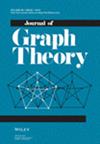Cycle-factors in oriented graphs
IF 0.9
3区 数学
Q2 MATHEMATICS
引用次数: 0
Abstract
Let be a positive integer. A -cycle-factor of an oriented graph is a set of disjoint cycles of length that covers all vertices of the graph. In this paper, we prove that there exists a positive constant such that for sufficiently large, any oriented graph on vertices with both minimum out-degree and minimum in-degree at least contains a -cycle-factor for any . Additionally, under the same hypotheses, we also show that for any sequence with and the number of the equal to 3 is , where is any real number with , the oriented graph contains disjoint cycles of lengths . This conclusion is the best possible in some sense and refines a result of Keevash and Sudakov.
定向图中的循环因子
设为正整数。有向图的循环因子是指覆盖图中所有顶点的长度不相交循环的集合。在本文中,我们证明了存在一个正常数,使得在足够大的情况下,对于任意......的顶点,任何同时具有最小出度和最小入度的有向图都至少包含一个-循环因子。此外,在同样的假设下,我们还证明,对于任意序列,且等于 3 的数为 ,其中为任意实数,且为 ,定向图包含长度为 的不相交循环。这个结论在某种意义上是最好的,并且完善了基瓦什和苏达科夫的一个结果。
本文章由计算机程序翻译,如有差异,请以英文原文为准。
求助全文
约1分钟内获得全文
求助全文
来源期刊

Journal of Graph Theory
数学-数学
CiteScore
1.60
自引率
22.20%
发文量
130
审稿时长
6-12 weeks
期刊介绍:
The Journal of Graph Theory is devoted to a variety of topics in graph theory, such as structural results about graphs, graph algorithms with theoretical emphasis, and discrete optimization on graphs. The scope of the journal also includes related areas in combinatorics and the interaction of graph theory with other mathematical sciences.
A subscription to the Journal of Graph Theory includes a subscription to the Journal of Combinatorial Designs .
 求助内容:
求助内容: 应助结果提醒方式:
应助结果提醒方式:


